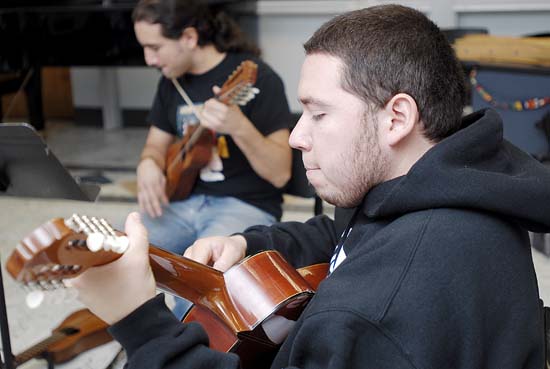UCLA students go back to their roots, back to “˜La Bamba’

Fourth-year ethnomusicology student Marcos Ruedas rehearses with his Mexican and Latin American ensemble, Grupo Folklorico de UCLA. Other Mexican music and heritage groups on campus include Mariachi Uclatan and Nucleo Jaraner de UCLA.
By Melissa Martin
Jan. 4, 2010 9:00 p.m.
Some say it all changed with a 17-year-old Angeleno with Mexican blood, coiffed hair, an electric guitar and two words set to be immortalized: “La Bamba.”
Released in 1958 by rock-and-roll legend Ritchie Valens, the Mexican folk song from Veracruz became one of rock’s earliest hits and helped begin the emancipation of Mexican music in the United States.
“He was really the first to take a traditional (Mexican) song and put it right into mainstream, popular American culture,” said Marcos Ruedas, a fourth-year ethnomusicology student.
The success of “La Bamba” helped ignite a period of rebirth in traditional Mexican music.
Today, Mexican American students strive to preserve their grandparents’ native music, hoping to promote cultural understanding and appreciation of the art.
As a result of facing prejudice when they first came to the United States, many Mexican musicians began playing other forms of music: swing, mambo, jazz and eventually rock and roll.
“They wanted to be like American popular bands,” ethnomusicology Professor Steve Loza said. “They wanted to compete with The Beatles, The Rolling Stones or James Brown. That was natural.”
But during the Civil Rights movement, Mexican Americans began reclaiming their rights, music and cultural pride.
“Groups like Los Lobos literally converted (back to Mexican music),” Loza said. “I remember one of them telling me back in high school they were playing rock and roll ““ The Stones and James Brown. Then all of a sudden it was, “˜Why aren’t we playing Mexican music? We should be proud of this music, not embarrassed by it.'”
The 1950s brought songs such as “Tequila” by Chuck Rio and The Champs, based on a Latin rhythm.
Later, artists such as Carlos Santana, Los Lobos and Selena helped Mexican music return to a joyous cultural celebration in the Mexican American community.
Artists and bands such as Lila Downs, Café Tacuba and Los Tigres del Norte helped fuse the gap between borders, experimenting with traditional sounds and regaining the attention of young listeners.
“They are definitely modernizing regional Mexican music and giving a new twist,” first-year ethnomusicology student Jazmin Morales said.
Morales said many listeners may not even be aware of the music’s origins but find it fun and catchy to listen to.
Many Mexican Americans are immersed in the music of their grandparents’ homeland at a young age ““ the brass of banda, Norteño accordions, the symbolic mariachi and rural Son Jarocho.
“I come from a family of musicians,” Morales said. “My dad guided me into the world of regional Mexican music. It was always just part of my life and family.”
Still, it proves challenging for some to appreciate music so withdrawn from American mainstream.
First-year doctoral student Alexandro Hernandez was a heavy metal guitar shredder growing up in Del Rio, Texas, but recalls his first introduction to what he calls his first cultural love ““ Son Jarocho music.
“When I was a kid, the film “˜La Bamba’ (a biographical film on Ritchie Valens) was popular. So of course they had us dance La Bamba. Not the rock-and-roll version, but a Son Jarocho version,” Hernandez said. “I remember my mom told me I just took off from home with the excitement that I wanted to go dance.”
Hernandez’s family raised him around traditional music. Yet it wasn’t until he was an undergraduate student at the University of Texas at San Antonio that his focus shifted from death metal to a somewhat more serene Son Jarocho.
Hernandez learned to play the traditional jarana, a guitar-like instrument used in the music, and studied the music in the rural lands around Veracruz.
Bringing this music back to the United States, Hernandez moved to Los Angeles ““ Son Jarocho’s biggest mecca outside of Veracruz, according to Hernandez ““ and studied the music at UCLA and joined several outside performance groups.
“It’s a really cool grassroots movement right now,” Hernandez said.
Hoping to preserve and share the traditional form of music within the UCLA community, Hernandez helped form a Son Jarocho group on campus, tentatively named Nucleo Jaraner de UCLA.
“With the group here at UCLA, I would like to be accessible to as many people as possible but also preserve it in the community for whoever else wants to participate in it,” Hernandez said.
Other Mexican music and heritage organizations on campus include Mariachi Uclatan, which has expanded the style of music in and around UCLA since the 1960s, making it one of the oldest university mariachi groups in America.
Grupo Folklorico de UCLA likewise preserves the native dance styles of Mexico and Latin America.
These groups and individuals seek to share one of the most recognizable elements of the Mexican culture and community.
“It has a broader significance than just playing music,” Ruedas said. “As people become more exposed to the cultures, you become more accepting of them. It leads to greater cultural acceptance and a greater popular society. It’s art, it’s beautiful, and people want to be exposed to it.”


